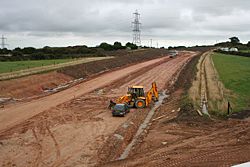A30/Bodmin - Indian Queens Dualling
| Bodmin - Indian Queens Dualling | |||
| Location Map ( geo) | |||
 | |||
| |||
| From: | Bodmin | ||
| To: | Indian Queens | ||
| County | |||
| Cornwall | |||
| Scheme Type | |||
| Bypass | |||
| Construction Start Date | |||
| 11 July 2005 | |||
| Opening Date | |||
| 25 June 2007 (to traffic) 11 July 2007 (official) | |||
| Cost | |||
| £93 million | |||
| Contractor | |||
| Alfred McAlpine | |||
| On road(s) | |||
| A30 | |||
The Bodmin to Indian Queens dualling scheme on the A30 in Cornwall was a scheme to dual one of the final sections of the route across Goss Moor. The single carriageway former route usually carried 24,000 vehicles a day, though on summer days, this rose to 30,000. The Iron Bridge, a low railway bridge crossing the A30 at this point was subject to frequent strikes by HGVs, causing significant delays. The scheme was the first in the UK to remove a trunk road from a European special area of conservation.
History
The dualling scheme was first backed by the government in 1987, only to be put on hold in 1995. Early plans for the scheme involved on-line dualling of the route, which would have been more destructive to the moor, though only estimated to cost £40 million. The original plans for the Indian Queens bypass, included a bypass for Goss Moor, though this never came to fruition.
In 2003, the AA named the A30 across Goss Moor as one of the worst bottlenecks in the country, alongside routes such as the M1 and M6. During the summer months, traffic would frequently build up along the Bodmin and Indian Queens bypasses, where the D2 route narrowed to S2 for the journey through Victoria and across Goss Moor. The contract for the new scheme was awarded to Alfred McAlpine in July 2002.
Following a public consultation for three months in 2003 in which 134 letters of support and 15 objections were received, the scheme to fill the gap went to a public enquiry in January 2004, with an announcement being made the following November that work would start in early 2005. Initial cost estimates for the scheme were around £49 million, though this later rose to £93 million, for which the Highways Agency was criticized. Unusually for a bypass scheme, it was generally supported by most environmental groups, including Friends of the Earth who agreed with the project in principle but weren't convinced that it should be built as dual carriageway.
Prior to the start of construction, residents of the nearby village of Roche threatened to blockade of the A30 as a result of fears regarding construction traffic passing through the village. They demanded that a haul route be constructed to avoid the village.
Rail Accident
On the Monday 8th May 2000 shortly after midday, an accident occurred on a level crossing alongside the A30 at Goss Moor. A car transporter was hit by a train travelling towards Newquay. The crossing is an automatic open crossing, and thus has no gates. It has been cited that the transporter was trying to avoid the low bridge on the A30 after it had triggered the height warning signs. The accident reinforced the problem of inappropriate alternative routes for high vehicles in the area.
Construction
Construction started on the 11th July 2005 on the new bypass, 10 years after the last dualling scheme on the A30 opened (The Fraddon and Indian Queens bypass, just to the west). During construction, 90% (700,000 tonnes) of waste china clay from nearby St Austell was used in construction of the road.
Between Sunday 20th November, until Sunday 4th December, the A391 was closed from Innis Downs roundabout, with a diversion route via the A389 and the former A391, now an unclassified road. The unclassified road used to see regular use on summer Saturdays, when it was used as part of a temporary layout to ease congestion at the main roundabout.
During construction in February 2006, a an ancient ceremonial circle-henge was discovered near Deep Tye Farm, estimated to be built almost 5000 years ago.
Prior to opening to traffic, a sponsored walk was organised along the new route on the 1st April 2007. In May 2007 the first stretch of bypass between Indian Queens and Victoria opened, allowing work to start on converting part of the old route into a bridleway and cycle route. The entire route opened on Monday 25th June 2007.
Further Reading
BBC News
SABRE forum topics


